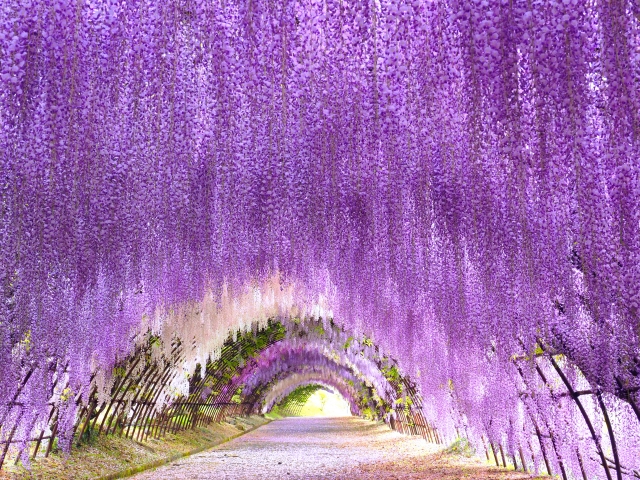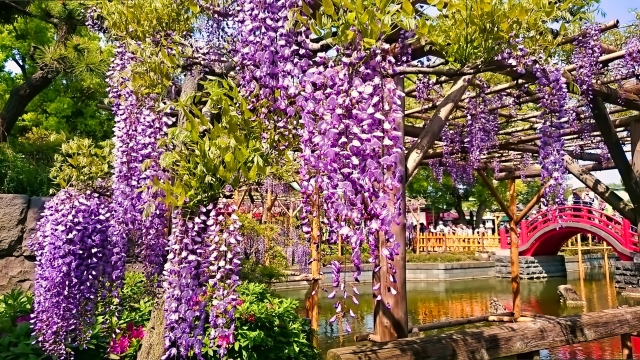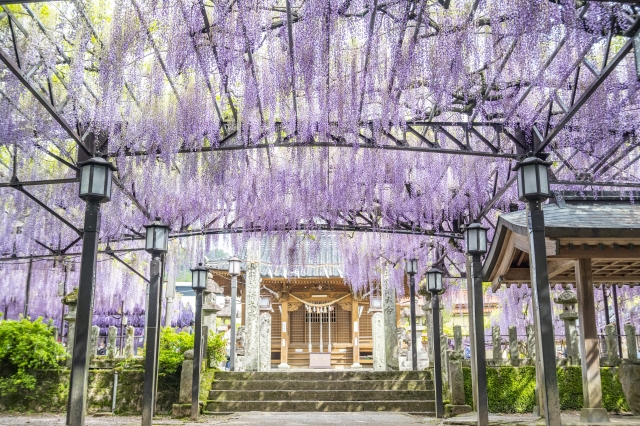Experience beauty of wisteria (fuji) in Japan, where cascading purple blooms create magical tunnels and enchanting garden scenes every spring.
This guide will help you plan the perfect wisteria viewing experience, from famous tunnels to hidden local favorites.
About Japanese Wisteria(“藤”)
Japanese wisteria (Wisteria floribunda) stands out among its global counterparts for its exceptionally long flower clusters, which can reach lengths of up to 150 centimeters.
These stunning purple, pink, or white blooms have been cherished in Japanese culture, often featured in traditional art and literature.
The most distinctive characteristic of Japanese wisteria is its counterclockwise twining habit, creating the perfect natural archways that have become famous worldwide. These woody vines can live for over 100 years, with some of Japan’s most celebrated specimens being more than 150 years old.
When to See Wisteria
Timing is crucial for the perfect wisteria viewing experience.
While exact blooming periods can vary slightly each year depending on weather conditions, understanding the general timeline and regional differences will help you plan your visit effectively.
Peak Blooming Season by Region
Wisteria flowering follows the cherry blossom front northward through Japan.
Here’s a detailed breakdown of peak viewing times by region:
| Region | Peak Blooming Period |
|---|---|
| Kyushu | Mid to Late April |
| Kansai & Kanto | Late April to Early May |
| Tohoku | Early to Mid-May |
| Hokkaido | Late May |
Best Time of Day
For the most enchanting wisteria viewing experience, consider these optimal visiting times:
- Early Morning (7:00-9:00): Perfect for photographers, with soft light and fewer crowds
- Late Afternoon (4:00-6:00): Beautiful golden hour lighting creates a magical atmosphere
- Overcast Days: Ideal for capturing the true colors of the flowers without harsh shadows
Weather Considerations
Weather plays a crucial role in both the blooming progression and viewing experience. Wisteria flowers are relatively delicate and can be affected by various weather conditions:
Optimal Viewing Conditions: – Mild temperatures (15-22°C) – Light cloud cover – Minimal wind – No rain
Heavy rain or strong winds can damage the delicate flower clusters, so check the weather forecast before your visit.
Top Wisteria Viewing Locations

Japan boasts numerous spectacular wisteria viewing spots, from famous tunnels that draw visitors worldwide to serene traditional gardens.
Here are the most remarkable locations where you can experience these magnificent blooms.
Famous Wisteria Tunnels
Japan’s wisteria tunnels offer some of the most mesmerizing flower viewing experiences in the world. These living corridors of cascading blooms create an almost otherworldly atmosphere.
- Kawachi Fuji Gardens (Fukuoka): Home to the most famous wisteria tunnels in Japan, featuring two stunning 100-meter tunnels with various wisteria species.
- Ashikaga Flower Park (Tochigi): Boasts Japan’s oldest wisteria tree (over 150 years old) and multiple tunnels. The park’s evening illumination creates a magical atmosphere.
- Tennogawa Park (Tsushima): Features a 275-meter wisteria tunnel, one of the longest in Japan
Historic Japanese Gardens

Traditional Japanese gardens offer a more intimate wisteria viewing experience, where the flowers are artfully integrated into classical garden landscapes.
- Byodoin Temple (Kyoto) – UNESCO World Heritage site – Ancient wisteria trees over 100 years old – Perfect combination of architecture and nature
- Kameido Tenjin Shrine (Tokyo) – Famous for its wisteria trellises over ponds – Traditional arched bridges enhance the view – Historical viewing spot since the Edo period
- Kasukabe Fuji Garden (Saitama) – Over 60 varieties of wisteria – Unique dome-shaped wisteria structures – Less crowded than major spots
Lesser-Known Hidden Gems
While famous locations draw crowds, these lesser-known spots offer equally beautiful wisteria viewing with a more peaceful atmosphere:
| Location | Notable Features | Best Timing |
|---|---|---|
| Tatebayashi Wisteria Park | 1,000+ wisteria trees, local atmosphere | Late April – Early May |
| Shirai Omachi Fuji Garden | Historic private garden, rare white wisteria | Mid April – Early May |
| Mandaraji Temple | 400-year-old wisteria tree | Late April |
These hidden gems often provide a more authentic experience and better opportunity for photography without crowds.
Essential Visitor Information
Planning your wisteria viewing experience requires attention to several key details to ensure the most enjoyable visit.
Admission Fees and Hours
Most notable wisteria viewing locations charge admission fees, which often vary by season.
During peak wisteria season, many venues extend their regular hours and offer special viewing experiences.
| Location | Regular Fee | Peak Season Fee | Special Features |
|---|---|---|---|
| Kawachi Fuji Gardens | ¥500 | ¥1,500-2,000 | Requires advance booking during peak |
| Ashikaga Flower Park | ¥900-1,700 | ¥1,700-2,300 | Evening illumination available |
| Kameido Tenjin | Free | Free | Traditional festival during peak |
Transportation Tips
Most wisteria venues are accessible by public transportation, though some may require a combination of train and bus travel.
- From Tokyo: – Ashikaga Flower Park: 2 hours by train – Kameido Tenjin: 30 minutes by train
- From Kyoto: – Byodoin Temple: 30 minutes by train – Kasukabe Garden: 4 hours by train
- From Fukuoka: – Kawachi Fuji Gardens: 1 hour by bus



comment